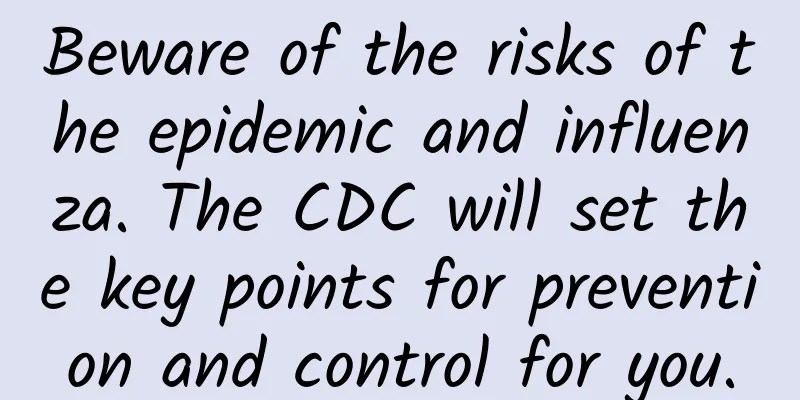Beware of the risks of the epidemic and influenza. The CDC will set the key points for prevention and control for you.

|
At present, the global COVID-19 epidemic is rising and falling. Autumn and winter are the peak seasons for respiratory diseases. There may be a risk of overlapping epidemics of COVID-19 and respiratory infectious diseases such as influenza in this autumn and winter. Influenza and COVID-19 are both respiratory infectious diseases. Doing a good job in influenza prevention and control can greatly reduce the risk of COVID-19. Shaanxi CDC will help you to focus on epidemic prevention. What is influenza? Influenza (flu for short) is a highly contagious respiratory infectious disease caused by influenza virus. Currently, the main infectors are the H1N1 and H3N2 subtypes of influenza A virus and the Yamagata and Victoria strains of influenza B virus. It is mainly spread through droplets such as sneezing and coughing, and can also be spread through direct or indirect contact with mucous membranes such as the mouth, nose, and eyes. In addition, contact with objects contaminated by the virus can also cause infection. Differences between Flu and Common Cold The clinical symptoms of a cold are mild, mainly manifested as sneezing, nasal congestion, runny nose, some may also cough, dry throat, itchy throat or burning sensation, rarely fever, rarely complications, weak infectiousness, generally 5-7 days to recover. Having a cold usually does not affect physical strength and appetite, and normal work and study are rarely affected. But influenza is very different! The main symptoms of influenza are fever, headache, myalgia and general discomfort. The body temperature can reach 39-40℃, and there may be chills and chills. It is often accompanied by systemic symptoms such as muscle and joint pain, fatigue, and loss of appetite. There are often sore throats and dry coughs. There may be nasal congestion, runny nose, discomfort behind the sternum, facial flushing, and conjunctival congestion. Some patients are characterized by vomiting, abdominal pain, and diarrhea. A very small number of severe patients may develop viral pneumonia, viral myocarditis, or viral encephalitis. Who is susceptible to influenza? The entire population is generally susceptible to influenza. In view of the COVID-19 situation this year, in order to minimize the harm of influenza and its impact on the prevention and control of the COVID-19 epidemic, the "Technical Guidelines for Influenza Vaccination in China (2020-2021)" recommends that key and high-risk groups be vaccinated in order of priority: 1. Medical personnel, including clinical treatment personnel, public health personnel, health quarantine personnel, etc.; 2. Vulnerable people and employees in places where people gather, such as nursing homes, long-term care institutions, and welfare homes; 3. People in key places, such as teachers and students in childcare institutions, primary and secondary schools, and detainees and staff in prisons and detention centers; 4. Other high-risk groups for influenza, including home-based elderly people aged 60 years and above, children aged 6 months to 5 years, patients with chronic diseases, family members and caregivers of infants under 6 months old, and pregnant women or women who are planning to become pregnant during the influenza season. People aged 6 months or older and without contraindications can receive influenza vaccine. Vaccination is an effective way to prevent influenza Flu vaccination is the most effective way to prevent influenza, and can significantly reduce the risk of contracting influenza and developing serious complications, but the flu vaccine needs to be administered every year. The main reason is that the influenza virus is very easy to mutate, resulting in different strains circulating each year, so it is natural to update the corresponding vaccine to protect against it. Around February every year, the World Health Organization will promptly release the northern hemisphere influenza vaccine strains based on the influenza virus epidemic situation. Generally, protective antibodies are produced 2-4 weeks after influenza vaccination, and antibody titers begin to decline after 6-8 months. Therefore, it is recommended to arrange vaccination as soon as possible after making an appointment. In the same influenza epidemic season, people who have completed the full vaccination according to the vaccination procedure do not need to be vaccinated again. In addition, autumn and winter are the peak seasons for respiratory diseases. While doing a good job in influenza prevention and control, we must also do a good job in preventing respiratory infectious diseases with other vaccines. In particular, we must do a good job in vaccination against measles, rubella, mumps, and chickenpox, which are diseases that cause epidemics and outbreaks in primary and secondary schools and childcare institutions. It is recommended that the elderly, children, and patients with chronic diseases receive pneumonia vaccines at the same time as influenza vaccines. Epidemic prevention behavior is important The effectiveness of some epidemic prevention behaviors and measures has been verified in the prevention and control of the new coronary pneumonia epidemic. Therefore, reducing the risk of exposure from the transmission link can also play a certain role in preventing influenza. 1. Wash your hands frequently After touching public facilities (such as door handles, elevator buttons, etc.); after covering your mouth and nose with your hands when coughing or sneezing; after touching coins or dirt, and when there are no visible contaminants on your hands, you can rub your hands with hand sanitizer for at least 20 seconds. 2. Wear a mask scientifically When wearing a mask, use both hands to press the metal strips on both sides of the bridge of the nose above the mouth and nose to make it fit tightly. Then pull the folds of the mask up and down to ensure that the mouth, nose and chin are completely covered. 3. Less gathering People should keep a distance between each other, avoid gathering in groups, and avoid going to crowded places. 4. Implement separate dining system Use serving chopsticks and spoons, and encourage buffets or separate meals; use self-service checkout to avoid crowds, and also reduce gatherings and dining together. 5. Environmental hygiene Clean, disinfect and ventilate the room properly. Offices and classrooms should be ventilated regularly every day. 6. Observe social etiquette Cover your mouth and nose when you cough or sneeze, wave instead of shaking hands when meeting someone, keep a distance of one meter when socializing, and take the elevator when there are more people. (Source: Shaanxi Center for Disease Control and Prevention WeChat account) |
<<: What are the best beaches in the Maldives? What delicious food is there in the Maldives?
>>: What currency does the Maldives use? Why do many people want to travel to the Maldives?
Recommend
Will frequent urination stop after entering the pelvis?
There are many factors that lead to frequent urin...
There is a lump in the breast when you pinch it
The breast is an extremely sensitive area for wom...
What is the reason for leucorrhea after ovulation
The ovulation period refers to the period of time...
What causes excessive saliva during pregnancy?
After pregnancy, due to certain changes in the bo...
What causes lower abdominal pain during early pregnancy?
Pregnant women who experience lower abdominal pai...
What menstrual problems will women encounter in their lifetime?
What age is normal for menarche? Q: I am 18 years...
What is the reaction to uterine erosion?
Although uterine erosion is a common pediatric di...
Examination before electrotherapy of cervical erosion
Cervical erosion is a relatively common gynecolog...
Distimo: Downloads from official app stores in April 2014: Google Play is lower than APP Store
According to the latest published data, the globa...
How to improve the success rate of pregnancy
According to the survey, if you have sex around t...
What pan should I use to fry steak? Which part of the steak is best?
There are many types of steaks, including fillet ...
Herpes on labia
Because if you do not pay attention to good hygie...
Female arm deltoid muscles are very prominent
What girls care most about is their body shape an...
How long does it take to fall out after medical abortion?
For women in early pregnancy, if they don't w...
Is there any connection between thyroid and pregnancy?
Some pregnant women are diagnosed with thyroid di...









